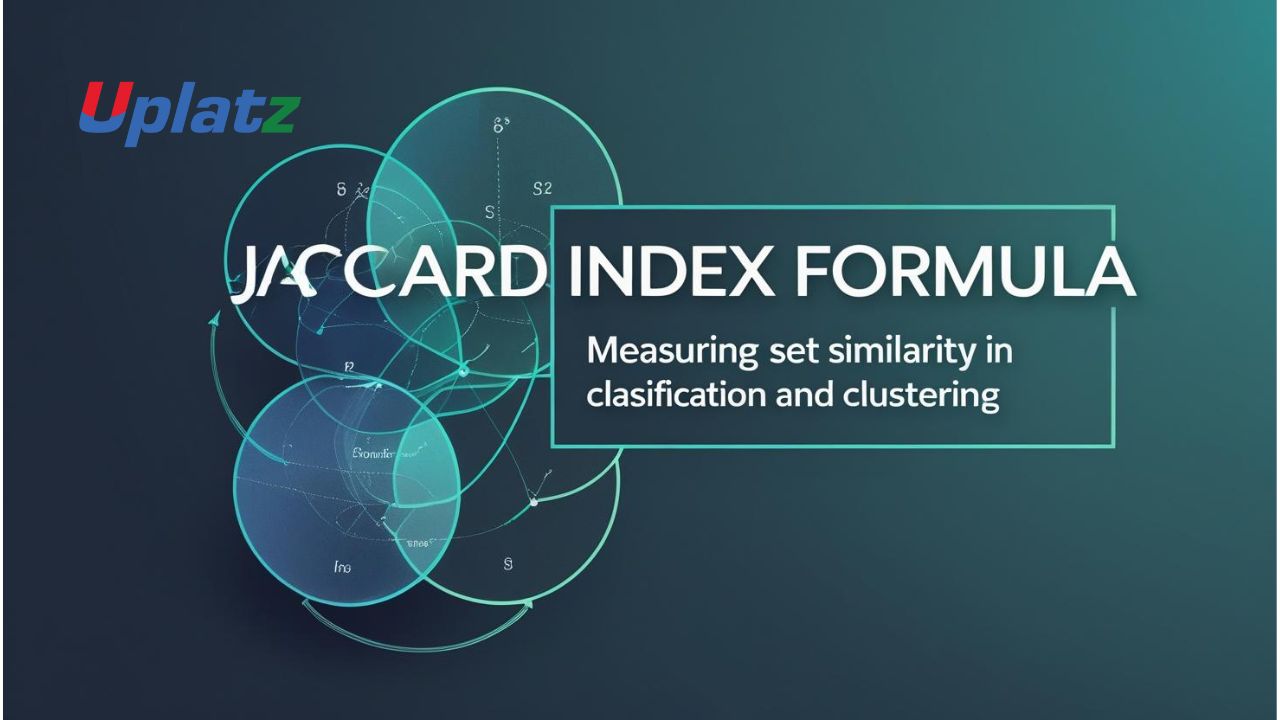 🔹 Short Description:
🔹 Short Description:
The Jaccard Index, also known as the Jaccard Similarity Coefficient, quantifies the similarity between two sets by dividing the size of their intersection by the size of their union. It’s widely used in clustering, classification evaluation, and text comparison.
🔹 Description (Plain Text):
The Jaccard Index, named after Swiss botanist Paul Jaccard, is a powerful mathematical tool for evaluating the similarity between two sets. It is especially useful when the data is binary or categorical, and is applied across numerous domains like image segmentation, recommendation systems, natural language processing, and clustering validation.
The formula is both elegant and intuitive, offering a direct measure of overlap between two datasets, normalised by the total number of unique elements across both sets.
📐 Formula
Let A and B be two sets.
Jaccard Index = |A ∩ B| / |A ∪ B|
Where:
- |A ∩ B| is the number of elements common to both sets (intersection)
- |A ∪ B| is the total number of unique elements across both sets (union)
The result lies between 0 and 1:
- 0 means no overlap
- 1 means complete overlap (sets are identical)
🧪 Example
Let A = {1, 2, 3, 4}
Let B = {3, 4, 5, 6}
- Intersection = {3, 4} → size = 2
- Union = {1, 2, 3, 4, 5, 6} → size = 6
Jaccard Index = 2 / 6 = 0.333
So, A and B are 33.3% similar based on their set overlap.
🧠 Key Characteristics
- Symmetry: J(A, B) = J(B, A)
- Insensitive to duplicates: Works with sets, not lists, so repeated items do not affect the score
- Normalization-friendly: Scales easily across datasets of various sizes
- Sparse-data suitable: Performs well with binary or 0/1 features and sparse vectors
🧰 Real-World Applications
- Document and Text Similarity
In NLP, the Jaccard Index compares texts based on the overlap of words, tokens, or n-grams. It’s frequently used for tasks like plagiarism detection, duplicate detection, and keyword-based similarity. - Recommendation Systems
To compare user profiles, viewing habits, or purchase histories. For example, two users might have watched similar movies, and the Jaccard Index will help quantify that similarity. - Machine Learning Classification
Used to evaluate the similarity between predicted and actual labels, particularly in multi-label classification problems. - Image Segmentation
In computer vision, the Jaccard Index (also known as Intersection over Union or IoU) is used to compare predicted image masks against ground truth in tasks like object detection. - Clustering Validation
When clustering data, Jaccard helps compare the overlap between the predicted clusters and the ground truth labels. - Biological and Medical Research
To compare gene sets, mutation profiles, or even protein interactions, offering insights into genetic similarity across samples.
📊 Comparison with Similar Metrics
- Jaccard vs Cosine Similarity
Cosine focuses on angle and vector direction; Jaccard focuses on discrete set membership. Cosine may be better for continuous data; Jaccard for binary or categorical data. - Jaccard vs Dice Coefficient
Dice coefficient (also known as Sørensen index) gives more weight to matches.
Dice = (2 × |A ∩ B|) / (|A| + |B|)
Jaccard is generally preferred when false positives are critical. - Jaccard vs Hamming Distance
Hamming measures mismatch; Jaccard measures overlap. Jaccard is more suited for sets and categorical variables.
🚦 Threshold Interpretation
The interpretation of Jaccard Index scores depends on context:
| Score Range | Interpretation |
| 0 | No similarity |
| 0.1–0.3 | Weak similarity |
| 0.3–0.5 | Moderate similarity |
| 0.5–0.75 | High similarity |
| > 0.75 | Very high or identical |
In practice, a Jaccard score > 0.5 is usually seen as a strong signal of similarity.
⚠️ Limitations
While useful, Jaccard Index has a few caveats:
- Binary dependence: Only compares presence/absence, ignoring frequency or weight
- Insensitive to semantic similarity: For example, “car” and “automobile” are different tokens but semantically similar
- Sparse vector dependency: Can be too harsh if sets are small or highly sparse
- Doesn’t scale well for huge, dense vectors—slower than cosine similarity on very large datasets
🔍 When to Use the Jaccard Index
Use Jaccard when:
- You’re comparing sets, tags, labels, or keywords
- The data is binary, categorical, or sparse
- Overlap matters more than magnitude or direction
- You need an intuitive similarity score between 0 and 1
- You’re working on multi-label classification evaluation
Avoid Jaccard when:
- The data is continuous or weighted
- Semantic meaning or vector direction is important
🧩 Bonus Tip
When working with multi-label classification, you can compute Jaccard per label or averaged across samples, using methods like micro/macro averaging to suit your evaluation needs.
📎 Summary
- Formula: J(A, B) = Intersection / Union
- Best for: Text, classification labels, user preferences
- Advantages: Simple, interpretable, robust for binary sets
- Limitations: Doesn’t capture context or weighting
The Jaccard Index remains a core similarity metric in any data scientist’s toolkit—straightforward to calculate, yet powerful in insight.
🔹 Meta Title:
Jaccard Index Formula – Measure Set Similarity for Text, Labels, and Clustering
🔹 Meta Description:
Master the Jaccard Index formula for evaluating similarity between sets. Explore its applications in machine learning, NLP, recommendation systems, and clustering. Learn how it works, where it fits best, and why it’s ideal for binary and categorical data.
